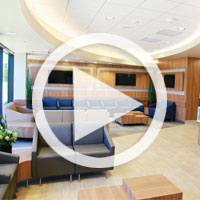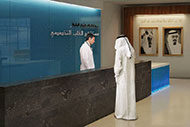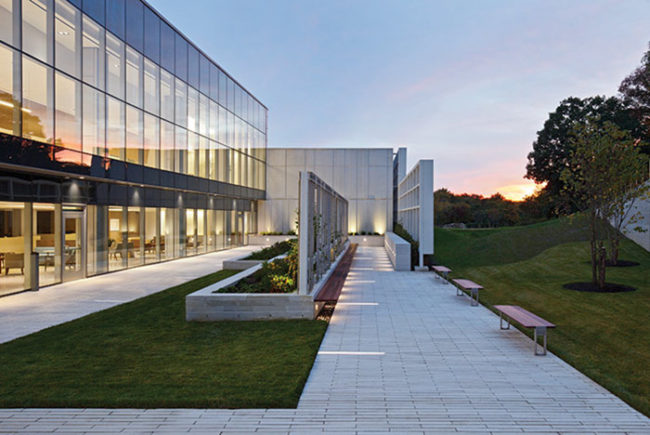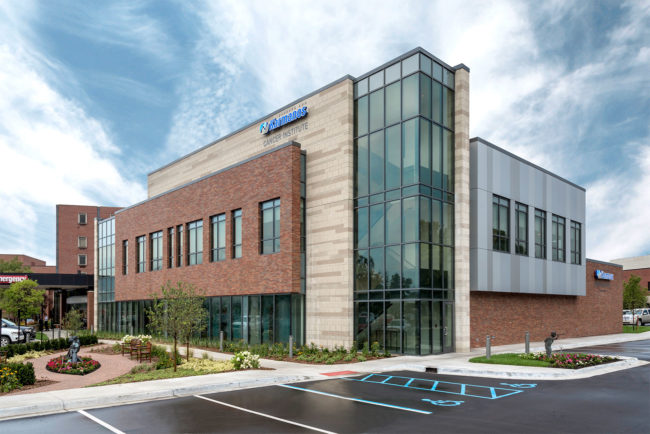
View "Designs for cancer care" Gallery
Cancer treatment that once was standardized and focused on treating the disease has become individualized and focused on healing the patient.
With reimbursements increasingly based on quality and service, patient-centered care is likely to grow even more. Patient satisfaction leads to an increase in volume, which results in higher revenues.
The built environment has become a critical part of the healing process and designing facilities that put the needs of the patient first has become the standard.
A successful interior must answer to the needs of cancer patients and their care providers throughout the facility’s common, treatment, patient services and staff areas.
Common areas
A cancer center’s common areas probably touch the widest variety of people and, therefore, must juggle a number of interests. Some key common spaces and their considerations include:
Main lobbies. Lobbies are a reflection of the perceived level of care a center provides. Because of the heavy volume of visitors in the lobby, additional steps for noise control, durable and safe flooring materials and easy wayfinding can contribute to overall satisfaction.
Locating the reception desk close to the entry ensures that patients do not have to walk far. The reception desk often is used to monitor and control the front and back entrances, so interior designers must account for security issues. Likewise, wheelchair storage should be adjacent to the reception desk so that they do not get parked in the lobby and contribute to an overly clinical feeling.
Elaborate artwork has become a staple in cancer center lobbies because of the positive effect it has on a patient’s experience. However, live plants can present a hazard to patients’ immune systems and should not be used.
When planning a donor recognition wall, designers should account for future growth by selecting the appropriate wall space, the practicality of updating it and the cost of adding new names to the existing displays.
Corridors. Long corridors present a challenge to fatigued patients. When travel distances cannot be made shorter, the perception of a shorter corridor through floor patterns, wall finishes and ceiling design can be psychologically positive. Curved walls should be considered because corridors appear shorter if they have no visible end. They also appear more private and not as busy.
Waiting rooms. A variety of furniture configurations provide patients with socialization preferences: Clusters invite interactions while linear layouts prevent feelings of awkwardness related to direct eye contact with other patients.
Chair selection might require customizing the firmness of the seat cushioning. During the course of cancer treatment, patients lose a lot of weight, and sitting on hard cushions can be painful. However, soft seating can limit their ability to pull themselves up.
Carpeted flooring is comfortable and inviting, but it can be hard for maintenance and wheelchair navigation. Carpet should only be used in the sitting area, and hard flooring should be used for the passages. Regarding color, people feel more secure on darker-hued floors.
Outlets for charging cellular phones and portable devices should be provided at chair height or integrated within the furniture. Family areas or lounges often are designed near waiting rooms, with comfortable soft seating and finishes that include a dining area with a kitchen.
About this article
This feature is one of a series of quarterly articles published by Health Facilities Management in partnership with the American Academy of Healthcare Interior Designers. 
Treatment spaces
A cancer center’s treatment areas must maintain a comforting environment while paying close attention to clinical issues like infection prevention. Key treatment area spaces and considerations include:
Infusion bays. The layout of the infusion area should allow for private, semiprivate or open bays. The configuration of the bays should be around the windows to maximize patients’ exposure to natural light and outside views. Visibility from the nurses’ station is best when the bays are grouped in a circle around it. In this case, the ceiling might be designed to bring in natural light.
The bays should be equipped with ample electrical outlets at shoulder height, storage for personal belongings, a guest chair and a TV or arm for portable devices. The selection of the recliner should be based on comfort, practicality and budget. Some recliners offer options like heating and massage.
Patients take many trips to the restroom during chemotherapy and it presents a tripping hazard and strength challenge for weak patients to push their IV poles over doorway transition strips. Carrying the same flooring material inside the restrooms will eliminate the need for them. From an aesthetic perspective, the pattern and color can be different for each space.
Hand-washing sinks and antibacterial gel stations should be added close to each bay to help prevent infections.
Radiation vaults. Radiation vaults are intimidating for patients in a cancer care facility. Even though it is hard to hide the volume of the linear accelerator, the key to reducing patients’ anxiety is to distract their eyes from it. Light technology is a better distraction than permanent art because it provides multiple selections depending on the patient’s gender and age. The size of the door can be concealed by designing a bafflelike entry so the door is no longer in sight. All medical supplies should be stored inside cabinets with closed doors.
Designers should consider long-term planning during space programming for the vault. With concrete- and lead-shielding requirements, walls cannot be moved easily. When it’s time to replace the equipment, a smaller room will limit the equipment choices.
Consultation rooms. Consultation rooms provide patients and doctors with space to talk about diagnoses and treatments. Arranging chairs around a table with hard floors and fluorescent lights can feel like an interrogation room. Instead, patients feel more at home sitting in a sofa with carpeted flooring and soft lighting. Equipment for these rooms includes a computer, wall-mounted monitor and a phone.
Exam rooms. Preserving the patients’ dignity is important in exam room design. Soundproofing the walls prevents confidential information from being overheard. The door location and swing direction as well as the placement of the exam table should ensure that the patient is not exposed when the provider walks in and out of the room. Adding a privacy curtain might be an easy solution for an existing space.
Patients need visual distractions while they are waiting in exam rooms for their providers. Finishes with warm colors and a wood-grain look, clutter-free counters and wall-mounted artwork can make an experiential difference.
Change rooms. Change rooms should be near the radiation and imaging rooms. Ample-sized rooms allow patients to receive assistance from family members.
Warm color schemes and soft lighting give the impression of a warmer temperature. Finishes like carpet and wallcoverings reduce the cold touch of hard surfaces. The use of mirrors for cancer patients is not recommended as their skin becomes pale and their hair might be thinning.
Patient services
Patient services areas are among the more unique aspects of cancer center design, providing such features as appearance boutiques and areas for thoughtful reflection. Some of the main spaces and particulars include:
Resource libraries. While resource libraries are infrequently used, they are still included in the programming of new cancer centers and can be more prominent with the right touches. A variety of seating options including clusters of club chairs, a small conference table and individual workstations can cater to a variety of users. Shelving for books and handouts should be minimal. The attendant’s desk should be located by the entry. Often located off the lobby, the resource library can be used as an alternate meeting area for small groups and can display artwork during some events.
Retail pharmacies. Retail pharmacies are a convenience to patients and staff. Patients do not always fill their prescriptions, and having a retail pharmacy on-site ensures that treatment is being followed. Oncology medications are complex, and pharmacies should include private counseling areas so patients can be educated on their safe use. A waiting room also is necessary.
Appearance boutiques. Appearance boutiques are becoming more popular in cancer centers. Patients are more likely to try on prosthetics when there is a private fitting area with a large change room, warm finishes and comfortable seating.
Displays should be designed to provide flexibility in showcasing different products. Patients are sensitive to light, and direct sources like track lights should be avoided unless the height and angle are properly placed.
Wellness rooms. Wellness programs as well as support and educational group meetings generally are held in the same space, often referred to as a flex room. A flex room can either have carpet or wood flooring, a projector for educational sessions, a sound system for music during yoga, and a built-in countertop with cabinets and sink. For meetings, folding tables with stackable chairs allow variations in the layout. Storage is needed within the room for the furniture and yoga props. The ideal location for a flex room is off the healing garden because it enhances the overall holistic nature of yoga, allows for relaxation during support groups and expands the physical space to include a garden for larger events.
Staff areas
Cancer center staff areas should reflect efficiency and safety in their interior designs. Some of the main staff spaces and their details include:
Nurses’ stations. Location of the nurses’ station should allow nurses to see patients, with measures in place to prevent patients from overhearing conversations among staff. Maximizing leg room facilitates cooperation among users, and planning for additional power and data provides flexibility for additional users.
Pharmacies and laboratories. Flow and future growth should be considered in the planning and design of laboratories; new equipment and technologies frequently replace existing ones and require different spatial and power needs.
Likewise, efficiency, sterility and safety are fundamentals for oncology pharmacies. The clinical area needs to be located close to the infusion area, while the operation area needs to be near the receiving area. Within the clinical area, chemotherapy medication is prepared in the intravenous room and sent to the patient in the infusion area. The oncology pharmacist should have a space within the infusion area at the nurses’ station to monitor and educate patients about their treatment.
The intravenous room has to go through a specific cleaning process. Therefore, the selection of materials and finishes should be seamless and nonporous. Door and window jambs, light fixtures and cabinet doors all should be selected with a low profile to make the room easily washable.
Windows within the rooms should be strategically placed for clear visibility. Error prevention and medication security are achieved by providing storage for hazardous and nonhazardous products. Additional design guidelines can be found in the USP 797 requirements.
Offices. The location of offices should allow privacy, encourage staff collaboration and be close to patient treatment areas. When locating the private offices, some health care models follow the concept of grouping them all in one area. However, spreading them throughout the facility keeps management and doctors near the patients and front-line staff. Radiation oncologists collaborate with dosimeters, so it makes sense to locate them in the same vicinity.
Staff lounges. While ergonomics and good lighting are important design considerations for staff, meeting their emotional and psychological needs should not be ignored. They should have access to respite areas and staff lounges that are away from the clinical and patient areas. Lounge design lies in the ability to create multiuser spaces to relax, eat, socialize or watch TV within one open room. Comfort and access to natural lighting are essentials for staff to fully replenish. Bulletin boards with work-related postings should be replaced with artwork.
Patient-focused approach
Cancer care design recognizes the significance and convenience of support programs for patients. During their visits, patients not only receive treatment, but also fill out their prescriptions, take yoga classes and participate in support groups.
New services for cancer care include rehabilitation programs for survivors that will prepare them to return to their normal lives. Some facilities are adding a full-time psychologist to attend to the emotional needs of the patients.
With the added amenities, the physical size of a center will also need to grow. But no matter what the physical size, a well-designed cancer center should make each patient feel that the facility was designed specifically for him or her. HFM
Ghina Itani, CHID, EDAC, ASID, is owner and principal designer of Itani Design Concepts, Bakersfield, Calif. She can be contacted at ghina@itanidc.com.
General design elements
Beyond the specific cancer care areas are general interior design rules that can be applied throughout a cancer center.
For instance, colors and lighting can help to change perception of space, alter a patient’s emotional state and enhance staff productivity. Generally, people feel more secure in spaces with warm colors. Cooler colors give the perception of a more open space and are recommended in areas with limited access to natural light or in small spaces with low ceilings.
Neutral colors can be calming, but also can increase boredom. When neutrals are used, accent colors with a higher saturation should be used to invoke an element of surprise. When selecting colors for finish materials, a neutral color can be used for doors and casework so they can last over time, while floor and wall coverings that need to be replaced more often don’t need the same long-term consideration.
Designers also should choose the right light temperature to complement the color scheme — cool colors are enhanced by cool light temperatures and warm colors are enhanced by warmer color temperatures. Light levels should be high in work areas and lower in lounges and other relaxing rooms. Cancer patients are sensitive to light so nondirect light sources with adjustable levels are recommended in patient areas.
When selecting art for cancer facilities, designers should consider the interpretation of subject matter from the patient’s perspective. Art that depicts nature is generally considered safe, but nature that features fallen leaves, dark subdued colors or freezing temperatures can have negative effects.
Digital art is an interchangeable solution that provides numerous choices for frequently returning patients. Digital art also can be integrated into the ceiling design of imaging rooms, or in wall-mounted displays in infusion and waiting rooms.
Finally, successful wayfinding systems integrate multiple methods of communication that recognize the diversity in people’s cognitive abilities.
Health care facilities face frequent changes that require signage to be updated regularly. Anticipating for the changes by selecting signs that can be replaced relatively easily ensures that there won’t be a combination of mismatched signs.
Signs should use high-contrast colors between the graphics and the background and easy-to-read font types and sizes. Consistency should be maintained within the overall branding of the organization, but the signs should be kept as simple as possible.





